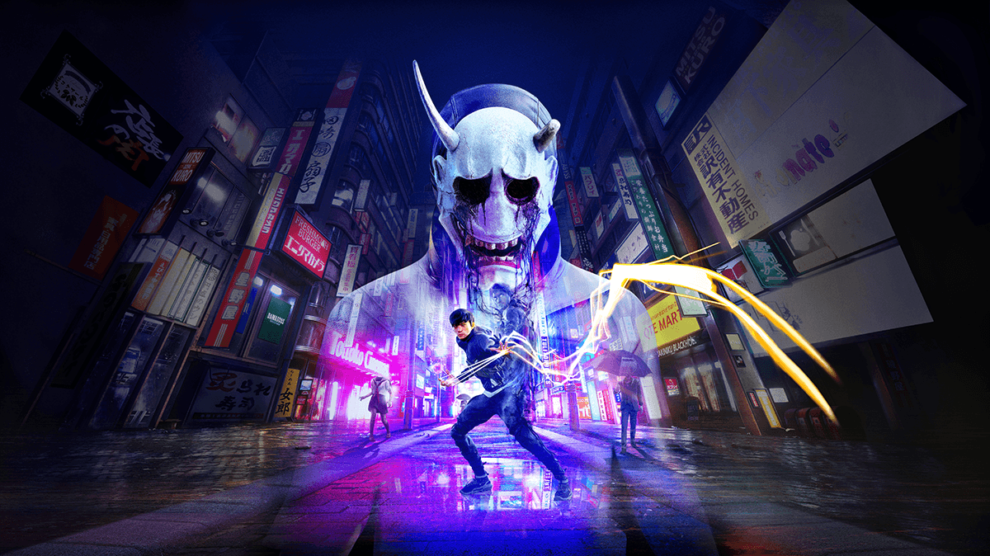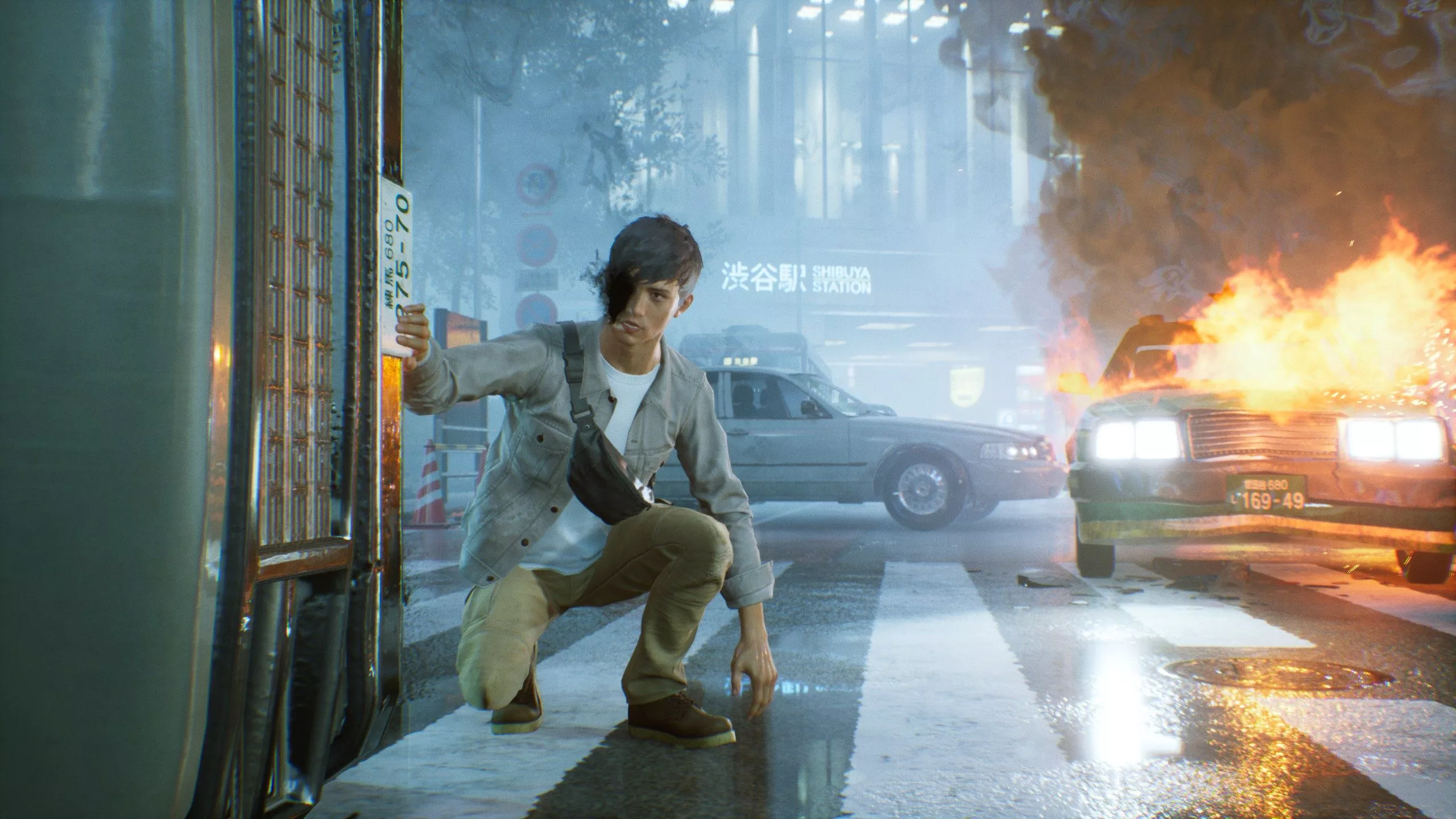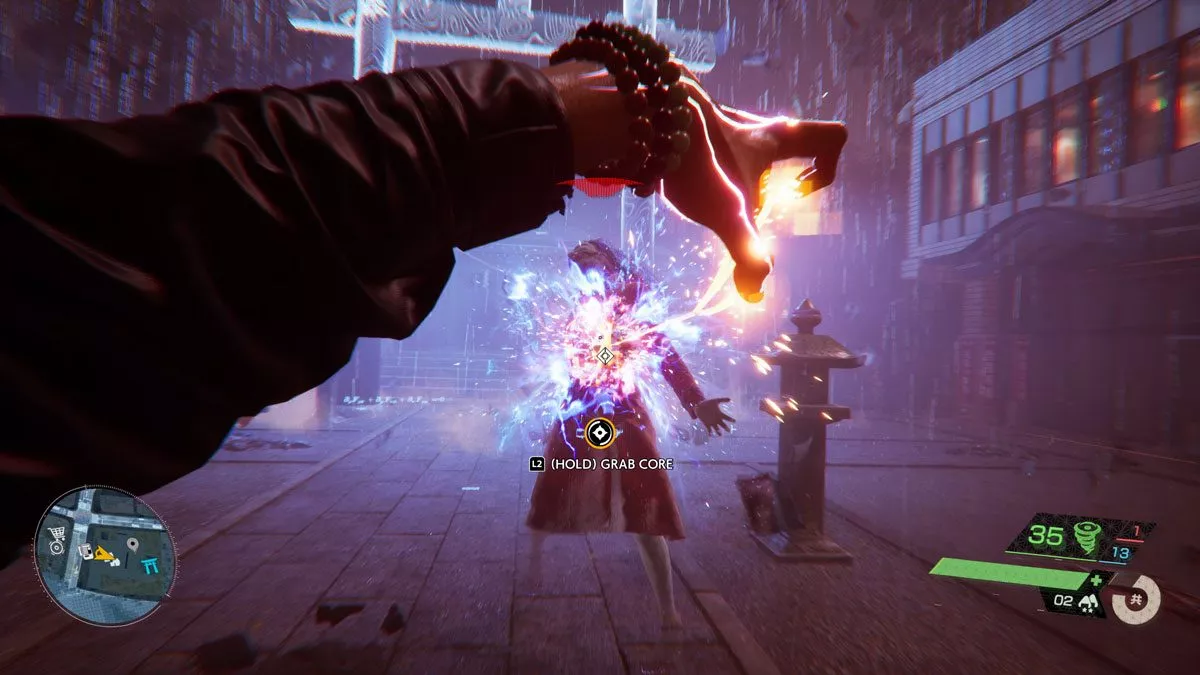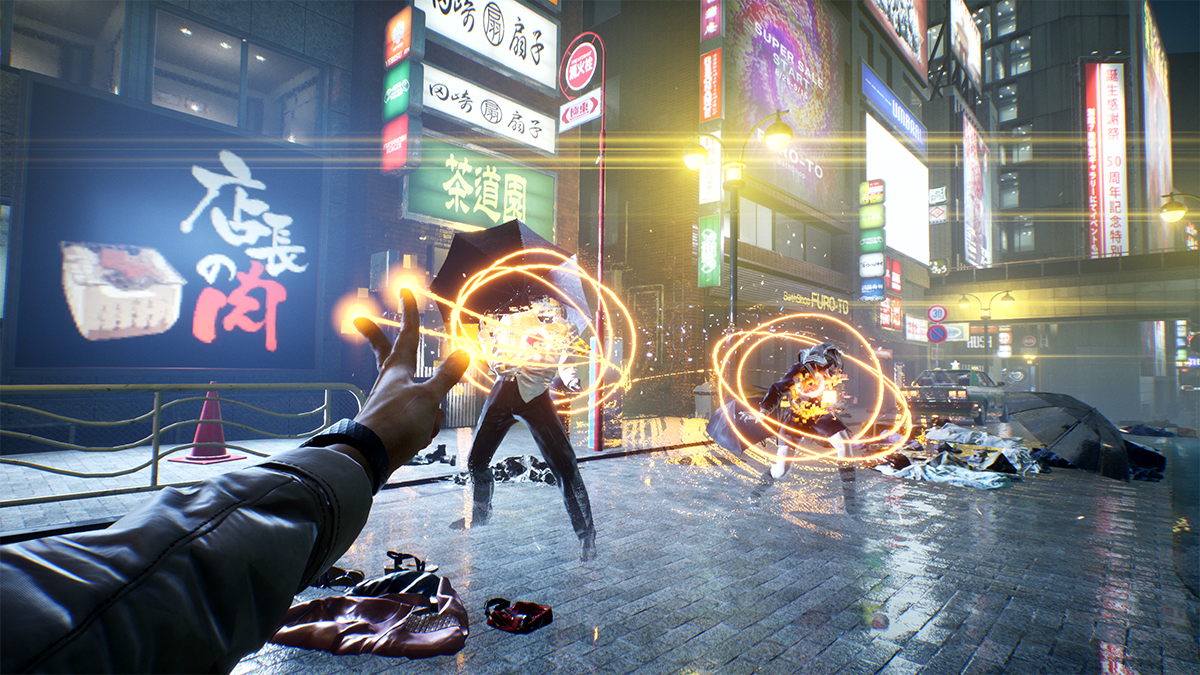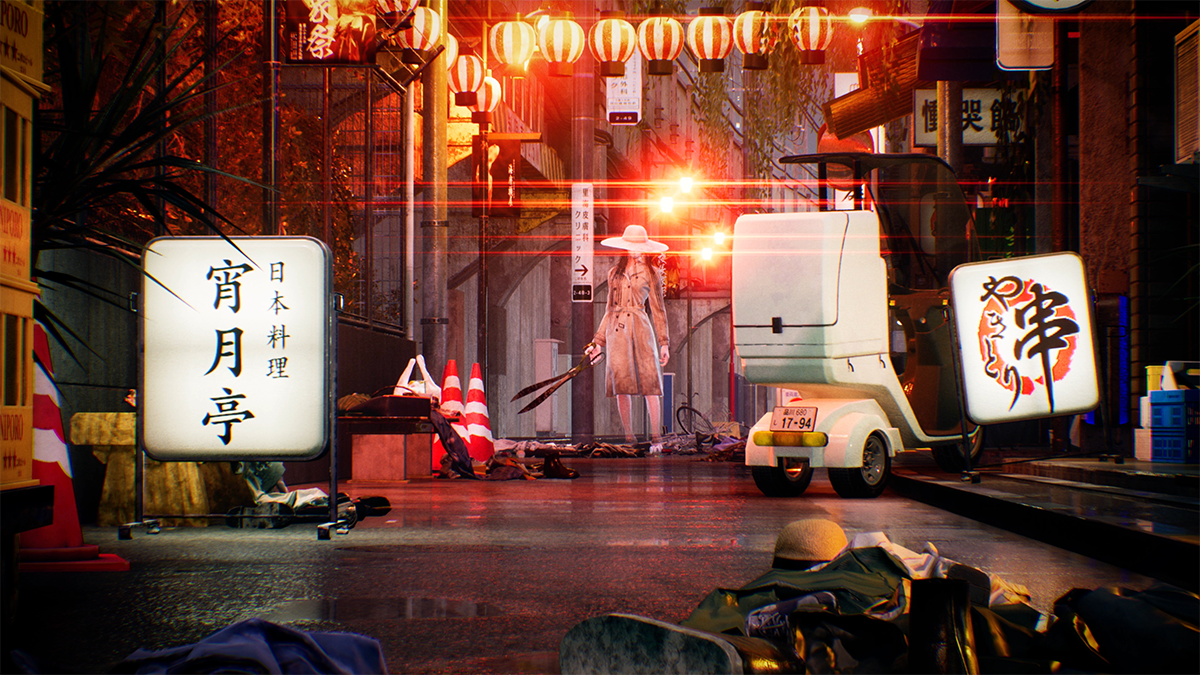Ghouls just wanna have fun.
Ghostwire Tokyo is the latest title helmed by Tango Gameworks’ Shinji Mikami, best known for his work on horror properties such as Resident Evil and The Evil Within. It’s a beast of a slightly different breed, placing you in the first-person perspective of Akito, an everyday guy in Shibuya who gets caught up in a supernatural invasion of Tokyo. What follows is a journey across the fabled city, facing down creatures of myth and folk tales as he does his best to restore the world to its usual state before time runs out.
Events open on a supernatural fog that sweeps through the city, causing everyone it touches to vanish; only their clothes are left behind, Rapture-style. Akito is one of only a few exceptions, but not for the best reasons; mere moments before this all goes down, he’s involved in a traffic accident which leaves him dead in the middle of the Shibuya Scramble Crossing. While this may be unfortunate for Akito, it does create an opportunity for our second main protagonist, spirit detective KK, as introduced in the free visual novel titled Ghostwire Tokyo Prelude.
Caught up in the same spooky event, KK’s soul is wrenched from his body and is only briefly protected by his own mystical gifts; the act leaves him just enough time to possess and revive Akito before their spirits are whisked away with the rest of Tokyo. Forming an uneasy alliance, Akito and KK agree to work together; KK will keep Akito alive through his possession and help him locate his sister, and in exchange Akito will help KK track down the man responsible for the disaster sweeping through their city.
Broadcasting his message from every screen in the area, a Hannya mask-wearing miscreant claims responsibility for the calamity, preaching a message that the body is a prison he’s freeing the city from. It’s clear this isn’t an altruistic move, so our two leads set out to put a stop to it. Moving through Ghostwire’s version of Tokyo, you’ll find yourself encountering a variety of beings from Japanese folklore referred to collectively as Visitors.
Ranging from mischievous to malicious, these creatures now inhabit every corner of Tokyo and include the likes of the Slenderman-esque Rain Walkers (spirits created by the exhaustion of nine-to-five salarymen), to cucumber-loving Kappa, and even Nurikabe – ghosts whose whole deal is that they like to hide doors. Faced with such horrors and/or inconveniences, it’s the responsibility of Akito and KK to sweep them all away, achieved through a variety of mystical skills that KK provides to his host.
Through the course of the narrative, you’ll gain access to three elemental energies — known in-game as Ethereal Weaving — that act like quintessential FPS weapons with a lot more style. Wind Weaving is a rapid-shot but low damage skill that acts as your pistol, Water Weaving is a wide-spread shotgun, and Fire Weaving acts essentially as a grenade launcher you can charge up to take out a number of enemies at once. You’ll also have a bow at your disposal for longer-ranged stealth attacks. The mid-range nature of combat offered through these systems take a little getting used to — many titles sit comfortably in either the long-range or close-up combat extremes — but once you get into the groove, it’s easy to spark joy.
Usually, weaving is your go-to; bouncing between your three elemental abilities quickly becomes instinctive, as does deflecting attacks with your shield ability. When you’re in the zone, you can instead focus on strategising against the different attack patterns your foes display. When sneaking up on an enemy to yank out their energy core doesn’t work out — and this close-quarters stealth tactic should always be considered as a first option — combat is about having your head on a swivel before the same thing happens to you. The basic Rain Walker enemies will follow you at a lesiurely pace, occasionally zipping closer unexpectedly, while female Visitors will fill the area with projectiles or heal other enemies.
Headless student Visitors will typically swarm you with (admittedly cool-looking) martial arts attacks or throw protractors at your head from a distance, while larger enemies such as the scissors-wielding Kuchisake (pictured below) will charge at you aggressively, doing their best to separate you from KK – and your head. For the most part however, enemies move relatively slowly so it’s easy to keep them at bay and control the crowd, picking off the weak links when up against a horde of vengeful spirits. You can upgrade your attacks and things like core grabs, and then it becomes a decision to simply fell enemies or go for stuns that provide more XP through core grabs. It’s a balance of risk and reward; if you go for a flourished finisher, you’re also leaving yourself open to attack.
Adding to the combat loop are items like stun signs — which do what you’d imagine — and a bow that allows you to take enemies out using stealth — and at a greater distance — if you want to shave down the stress of a larger-scale encounter before diving in. It’s also a requirement at times; as you progress through the story, some higher-tier enemy types like the Kuchisake will sever the connection between Akito and KK, yanking the spirit out of your body and negating your Weaving skills. Until you’re able to retrieve the grouchy spirit detective in these moments, the bow is your last line of defence.
The charge time required to line up a bow shot makes it less useful in the midst of a combat encounter, only helpful when you’ve burnt through everything else in your arsenal or have a ghost roomie to track down. It’s also the cause of one of the few frustrations I experienced in Ghostwire — I kept swapping between magic and my bow by accidentally brushing the DualSense’s touchpad while moving its left analog stick. The functionality can’t be remapped and there’s no option to create a touchpad “dead zone” like in games such as Ghost of Tsushima, so I instead found myself fighting against an additional enemy in every fight: my own lack of hand-eye coordination.
The far-superior Weaving skills are also just fun to watch; the smoothness of Akito’s gestured-based weaving always makes you feel like the coolest guy in the deserted metropolis, and the final gesture when sealing a malicious spirit feels dramatic every single time. When you manage to stagger multiple enemies at once to destroy them all simultaneously, you feel like you really could be Tokyo’s saviour. Don’t even get me started on how fantastic and fluid finishers look – often after defeating one of the higher-difficulty enemy types, Akito will bust out a cool gesture all on his own to make you feel like an urban wizard.
On the topic of visuals, Ghostwire Tokyo does a tremendous job of showcasing its third real protagonist: Tokyo itself. From rain-slicked streets, colourful neon signs and well-kept alleyways all perpetually drenched in the unnatural red light of a blood moon, Ghostwire feels like being in the real locale… though admittedly not at the best time. The discomfort of wandering through a silent city you know should be bustling 24/7 — broken up only by the tinny sounds of convenience store music and the crackling radio sounds indicative of nearby Visitors — puts the mind on edge, without being relentless.
The player also has skills including a mechanic that allows you to use flying Tengu spirits as a long-distance grappling hook, and the quintessential ‘radar sense’ ability typical of every open-world game at their disposal. The latter affords you a view of any collectibles, enemies or points of interest in your immediate area. Zipping your way up high is actively encouraged when it comes to traversal, allowing you to circumvent enemies via rooftops littered with goodies for you to find. Combined with the ability to glide and Akito can essentially fly for a brief period of time, which allows the player the chance to get creative when moving from rooftop to rooftop. Traversal in this mystical manner adds to variety in exploration and combat, allowing you to take in more of the wonders of Tokyo or simply position yourself to deliver a punishing stealth attack.
I was actually quite surprised to find such an emphasis on traversal to be the case; based on early coverage and Mikami’s previous works, I assumed that Ghostwire Tokyo would be all about moving through cramped Tokyo streets, leaning into the claustrophobic, survival horror vibe that the Resident Evil franchise is known for. The thought left me apprehensive as a scaredy-cat, but thankfully Ghostwire has an entirely different vibe by its very nature.
For those who get anxious over the possibility of jump-scares, you can rest easy. As intense as some of the combat encounters can be, Mikami’s latest work isn’t here to try and make you take an unplanned bathroom break; that said, if I never have to deal with another lamentation spirit, it’ll still be too soon. The sum of its parts means that Ghostwire Tokyo has created its own genre niche, somewhere between a first-person shooter and an open world collectathon that tickles a new spot in the brain for players who like to do it all (and perhaps learn something in the process).
Outside of combat, our protagonist duo will frequently come across clumps of spirits in the city, made up of the souls of Tokyo natives affected by this crisis. Absorbing these spirits using katashiro paper dolls allows you to send them out of the danger zone from a payphone, saving the people involved and rewarding you with XP and money in return. While missions do reward you with these as well, the cycle of absorbing and depositing spirits is your bread and butter when it comes to upgrading your skills and keeping fully stocked with health-restoring items — all of which look delicious.
Even before upgrading your ability to absorb these spirits faster, collection never feels like a chore. You’ll rarely go more than a minute without passing some by, so it never feels like a task you specifically need to set aside time for. Side missions, Torii Gates and clearing corruption trees all reward you with a few spirits as well, so your skill points are always ticking up towards that next upgrade you’re eyeing. Each area of the map also has a progress bar to indicate how many spirits you’ve found and transferred, as well as a master count for those across Tokyo. Having a concrete goal to work towards, while being rewarded constantly along the way, keeps spirit collection from feeling tedious the way it could with something less intelligently designed.
The mechanic behind the aforementioned health-restoring consumables is one I’ve not encountered before. Each time you consume a restorative item like a skewer of yakitori chicken, your health will not only be refilled as you’d expect, but you’ll find your health bar will also be expanded by a meager-sounding 0.4 points. While that small boost admittedly doesn’t amount to much – even basic enemies like Rain Walkers pack enough of a punch to take you out in a couple of hits – it certainly adds up over the course of proceedings.
The more trouble you have staying alive, the more your ability to stay alive will expand; the idea is again demonstrative of Ghostwire‘s overall very smart design. This example feels more like a reward for persevering than an exercise meant to shame you for your skill. Each time you level up your health bar will also expand by 2%, meaning that endgame Akito will be a powerhouse compared to the one that was first revived in Shibuya.
You’ll also encounter collectible Relics, items from Japanese culture and history sought out by the Nekomata cat spirits now populating the desolated Tokyo (who have also taken it upon themselves to manage the convenience stores across the city too). While these do include items from history and mythology that you might expect to see, some are a lot more recent and surprising – one cat spirit specifically seeks out items like old flip phones and magazines, bringing a lot more variety to the items you’re hunting down. Each collectible in this category can then be exchanged for substantial sums of money from each Relic-loving Nekomata, and will fill a database with info about Japanese life past and present that I found engrossing.
Side missions also provide insight into Japanese customs and culture, and are welcome experiences that offer more than simply an item to tick off the list when complete. A number of side missions will require Akito to draw a hand sign to complete them, though a simple button press will let KK take care of it for you if lack the inclination or skills with the right-stick. Why drawing wasn’t done using the DualSense touchpad is a mystery… that is, until you remember that the title is also available on PC; it’s a bit tough without DualSense support. While drawing the signs to banish a spirit does feel cool to do at first, the number of times the action is required over the course of the game does dull the excitement over time. Nevertheless, players who opt to hand over the reins to KK will still get to perform a final strike which lets you own the moment of victory regardless.
For western audiences, this is a deep dive into a cultural identity we may not be familiar with; learning about all the very specific types of ghosts in Japanese lore is as entrancing as its gameplay. After finishing its main campaign I was eager to dive back in and take in everything its world had to offer. I also really enjoyed playing with audio options; by default, Akito and KK will converse in Japanese, with English subtitles of course assisting the player if they don’t understand the language. For dub-over-sub blasphemers such as myself, you can also switch to English or a host of other vocals if you prefer. The level of emotion and gravitas behind the vocal performances certainly transcend the language barrier regardless of your preference, in turn adding to the overall experience. It’s something akin to an Assassin’s Creed Discovery Tour, but with cultural content baked in through fun and exciting gameplay systems, and of course coupled with fantastic visuals and dynamic combat.
With plenty of fun and engaging diversions across its expansive map and a polished narrative that draws you into the plights of its compelling protagonists, Ghostwire Tokyo makes an impressive impression for a new IP from Tango Gameworks. The studio has not only shifted from a third- to first-person perspective — creating something of a new genre at the same time — it’s also pulled out all the stops while doing so. Whether you’re soaring across the rooftops of Japan, chasing down mischievous spirits in the backstreets, pulling off Naruto-jutsu-esque hand seals or just beating the snot out of a guy in a Hannya mask, you’re never lacking for something fun to do.
If you’re looking for an open world with a different flavour to everything else, diving into the fog-filled streets of Ghostwire Tokyo is just the right fit. Stock your quiver, practice your hand gestures and get ready to be the yokai cool guy you were born to be.
Ghostwire Tokyo was reviewed using a promotional code on PS5, as provided by the publisher. A second promotional code on Windows PC via Steam was used for supplemental coverage. Click here to learn more about Stevivor’s scoring scale.
 |
Ghostwire Tokyo25 March 2022, 12 April 2023PC PS5 Xbox Series S & X |
This article may contain affiliate links, meaning we could earn a small commission if you click-through and make a purchase. Stevivor is an independent outlet and our journalism is in no way influenced by any advertiser or commercial initiative.























